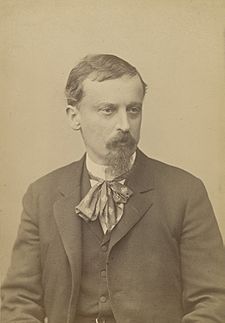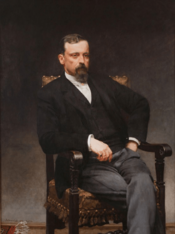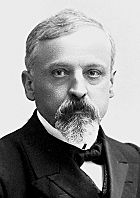Henryk Sienkiewicz facts for kids
Quick facts for kids
Henryk Sienkiewicz
|
|
|---|---|

Sienkiewicz in the 1880s, photograph by Stanisław Bizański
|
|
| Born | Henryk Adam Aleksander Pius Sienkiewicz 5 May 1846 Wola Okrzejska, Lublin Governorate, Congress Poland |
| Died | 15 November 1916 (aged 70) Vevey, Switzerland |
| Occupation | writer, novelist, journalist |
| Language | Polish |
| Nationality | Polish |
| Period | 19th–20th century |
| Notable works |
|
| Notable awards | Nobel Prize in Literature 1905 |
| Signature | |
Henryk Adam Aleksander Pius Sienkiewicz (born May 5, 1846 – died November 15, 1916) was a famous Polish writer. He also used the pen name Litwos. He is best known for his historical novels, especially Quo Vadis. This book became a worldwide bestseller.
Sienkiewicz was born into a Polish noble family that had lost most of its wealth. This was in a part of Poland ruled by Russia. He started writing for newspapers and magazines in the late 1860s. In the late 1870s, he traveled to the United States. His travel stories made him very popular in Poland.
During the 1880s, he began writing novels that were published in parts, like a TV series. This made him even more famous. Soon, he was one of the most popular Polish writers of his time. His books were translated into many languages, bringing him international fame. He won the 1905 Nobel Prize in Literature for his amazing writing.
Many of his novels are still read today. In Poland, he is famous for his "Trilogy" of historical novels. These are With Fire and Sword, The Deluge, and Sir Michael. They are set in the 17th-century Polish-Lithuanian Commonwealth. Around the world, he is most known for Quo Vadis. This story takes place in ancient Rome during Emperor Nero's time. Both The Trilogy and Quo Vadis have been made into movies. The 1951 Hollywood movie of Quo Vadis is especially well-known.
Contents
Henryk Sienkiewicz's Life Story
His Early Years
Henryk Sienkiewicz was born on May 5, 1846. His birthplace was Wola Okrzejska, a village in eastern Poland. At that time, this area was part of the Russian Empire. His family were Polish nobles, but they were not rich. His father was Józef Sienkiewicz and his mother was Stefania Cieciszowska.
The family moved several times during Henryk's childhood. He spent his early years on family estates in different villages. In September 1858, he started school in Warsaw. His family finally settled there in 1861. Henryk's school grades were not very good, except for subjects like Polish language and history.
When he was 19, Sienkiewicz worked as a tutor to help his family. He probably wrote his first novel, Ofiara (Sacrifice), around this time. He is thought to have destroyed this book. He also worked on his first published novel, Na marne (In Vain). He finished high school in 1866.
He first tried to study medicine, then law, at the University of Warsaw. But he soon switched to studying literature and history. He learned a lot about old Polish language and literature. He lived in poverty for a while, tutoring part-time. His situation got better in 1868 when he tutored for a princely family.
Starting His Writing Career
In 1867, Sienkiewicz wrote a poem called "Sielanka Młodości" ("Idyll of Youth"). A magazine called Tygodnik Illustrowany (The Illustrated Weekly) did not publish it. In 1869, he started his career as a journalist. His first review of a play was published in Przegląd Tygodniowy (The Weekly Review). Soon after, The Illustrated Weekly printed his essay about a Polish poet.
He finished his university studies in 1871. However, he did not get a diploma because he failed a Greek language exam. Sienkiewicz also wrote for other newspapers, using the pen name "Litwos." He wrote regular columns for different publications. In 1874, he helped translate Victor Hugo's novel, Ninety-Three.
In 1872, he published his first fiction work, a short novel called Na marne (In Vain). This was followed by other stories like Humoreski z teki Woroszyłły (Humorous Sketches from Woroszyłła's Files, 1872). His stories Stary Sługa (The Old Servant, 1875), Hania (1876), and Selim Mirza (1877) are known as the "Little Trilogy." These writings made him well-known in Warsaw's literary world.
Traveling and Adventures
In 1876, Sienkiewicz traveled to the United States. He went with Helena Modrzejewska, an actress who became famous in the U.S. He traveled through London to New York and then to San Francisco. He spent some time in California. His travels were paid for by a newspaper called Gazeta Polska. In return, he wrote a series of travel essays. These were published as "Letters from a Journey" and "Litwos' Letters from a Journey."
While in America, he continued writing stories. He published "Charcoal Sketches" in 1877. He also wrote a play. He explored different parts of America, including Native American camps and mountains. He even visited the Mojave desert. On August 20, 1877, he saw Modjeska's first play in San Francisco. He wrote a review of it for The Polish Gazette.
On March 24, 1878, Sienkiewicz left the U.S. and returned to Europe. He stayed in London and Paris for a year. He delayed his return to Poland because he heard rumors of a new war with Turkey. He worried he might be forced to join the Russian army.
Back in Poland
In April 1879, Sienkiewicz returned to Poland. He gave lectures about his travels, which became very popular. In late 1879, he visited Venice and Rome. He returned to Warsaw on November 7, 1879. There, he met Maria Szetkiewicz, and they married on August 18, 1881. They had two children, Henryk Józef and Jadwiga Maria. Sadly, Maria died of tuberculosis on August 18, 1885.
In 1879, the first collection of Sienkiewicz's works was published. He also continued writing for newspapers. In 1881, he became the editor-in-chief of a new Warsaw newspaper called Słowo (The Word). This helped his financial situation a lot. He published many columns and short stories in the newspaper.
However, he soon wanted to focus more on writing books. He paid less attention to his editor job and resigned in 1887. But he stayed as the editor of the paper's literature section until 1892.
From 1883, he started writing more historical novels. He began working on Ogniem i Mieczem (With Fire and Sword). This book was published in parts in The Word and another newspaper.
Sienkiewicz then wrote the second book of his Trilogy, Potop (The Deluge). It was also published in parts from 1884 to 1886. After his wife's death, he continued traveling in Europe. He left his children with his late wife's parents. He often returned to Poland, especially to Warsaw and Kraków.
In 1887, the third book of his Trilogy came out. It was Pan Wołodyjowski (Sir Michael). The Trilogy made Sienkiewicz the most popular Polish writer of his time.
An unknown admirer gave Sienkiewicz 15,000 rubles as a gift. Sienkiewicz used this money to create a fund to help artists who had tuberculosis.
In 1886, he visited Istanbul. In 1888, he went to Spain. At the end of 1890, he traveled to Africa. This trip resulted in his book Listy z Afryki (Letters from Africa). In 1891, his novel Without dogma was published. In 1892, he signed a deal for another novel, Rodzina Połanieckich (Children of the Soil), which came out in 1894.
Later Life and Nobel Prize
In 1904, Sienkiewicz married his niece, Maria Babska.
Sienkiewicz used his growing fame to help Poland. At that time, Poland was divided among Russia, Austria, and Prussia (later Germany). He often spoke out against Germany's efforts to make Poles speak German. In 1901, he supported schoolchildren who protested against banning the Polish language. He also asked the Russian government to make changes in the part of Poland they controlled.
During a revolution in Poland (1905–07), he supported more freedom for Poles within the Russian Empire. He helped create monuments to the famous Polish poet Adam Mickiewicz. He also supported education and helped start an organization for Polish schools. By 1908, he was quite wealthy from his books. He often used his money to help other writers and social projects.
In February 1895, he started writing Quo Vadis. This novel was published in parts in several newspapers. It was finished by March 1896. The book quickly became famous around the world. In February 1897, he began writing another novel, Krzyżacy (The Knights of the Cross). This book was finished in 1900.
In 1900, Sienkiewicz celebrated 25 years as a writer. Special events were held in many Polish cities. The Polish people gave him a gift: an estate at Oblęgorek. He later opened a school for children there.
In 1905, he won the Nobel Prize for his lifetime achievements as a writer. In his speech, he said this award was very special for a son of Poland. He said, "She was pronounced dead – yet here is proof that she lives on.... She was pronounced defeated – and here is proof that she is victorious."
His social and political activities meant he wrote fewer books. He wrote a new historical novel, Na polu chwały (On the Field of Glory). It was meant to be a new trilogy, but it was never continued. His 1910 novel for young people, W pustyni i w puszczy (In Desert and Wilderness), was very popular among children and teenagers.
When World War I started, Sienkiewicz left for Switzerland. He helped create an organization to help Poles affected by the war. He also supported the Red Cross.
His Death and Legacy
Henryk Sienkiewicz died on November 15, 1916, in Vevey, Switzerland. He was buried there on November 22. He died from a heart condition. Representatives from many countries attended his funeral.
In 1924, after Poland became independent again, Sienkiewicz's body was brought back to Warsaw. He was buried in the crypt of St. John's Cathedral. Thousands of people joined the procession to his resting place. Poland's President gave a speech honoring him.
Henryk Sienkiewicz's Famous Books
Sienkiewicz's early works often showed his support for "Polish Positivism." This idea encouraged modernizing Poland and practical actions. His "Little Trilogy" (Stary Sługa, 1875; Hania, 1876; Selim Mirza, 1877) showed his interest in Polish history. These stories also showed his skill with humor and drama. His early works often focused on the struggles of poor people, schoolchildren, and immigrants.
His story "Latarnik" ("The Lighthouse keeper", 1881) is considered one of the best Polish short stories. His 1882 stories "Bartek Zwycięzca" ("Bart the Conqueror") and "Sachem" compared the sad fates of their heroes to the situation of Poland, which was under foreign rule.
His novel With Fire and Sword (1883–84) was very popular with readers. It became an "instant classic." This book is set in 17th-century Poland. Critics liked his writing style, but some noted that historical facts were sometimes changed. The book combined elements of an epic story and a historical novel. It also had Sienkiewicz's unique writing style.
His novel Without dogma (1889–90) was an interesting experiment. It was written like a made-up diary where the main character analyzes himself. Sienkiewicz believed that novels should make life stronger and better, not weaken it.
These ideas influenced his novel Quo Vadis (1896). This story is about early Christians in Rome who faced challenges from Emperor Nero. The book drew parallels between the persecuted Christians and the Poles of Sienkiewicz's time. It became very popular in Christian countries. The triumph of spiritual Christianity over the material world of Rome was a message against materialism. It also showed the strength of the Polish spirit.
His book Teutonic Knights (1900) returned to Polish history. It describes the Battle of Grunwald (1410). This was a big victory for Poland and Lithuania over the Teutonic Knights. The book quickly became another bestseller in Poland. It was also praised by Polish groups who were against Germany. After Poland became independent in 1918, this book became part of the school curriculum.
It is often thought that Sienkiewicz won his Nobel Prize only for Quo Vadis. However, the Nobel Prize committee said he won for his "outstanding merits as an epic writer," recognizing all his great works.
Sienkiewicz often did a lot of historical research for his novels. But he chose which facts to include. For example, he focused more on Polish military victories than defeats.
How Henryk Sienkiewicz Was Honored
Around the year 1900, Sienkiewicz was the most popular writer in Poland. He was also very popular in Germany, France, Russia, and English-speaking countries. His Trilogy was translated many times. With Fire and Sword had at least 26 translations during his lifetime. Quo Vadis became extremely popular, translated into at least 40 languages. Over a million copies were sold in English.
His works were made into plays, operas, and movies. Writers and poets wrote works about him. Painters created art inspired by his novels. The names of his characters were even used for products. The popularity of Quo Vadis in France was so great that horses in a famous race were named after characters from the book. In the United States, Quo Vadis sold 800,000 copies in just 18 months.
Sienkiewicz was made a member of many international groups. These included the Polish Academy of Learning and the Russian Academy of Sciences. He received the French Légion d'honneur (1904). He also received honorary degrees from Polish universities. In 1905, he received the Nobel Prize, the highest award in literature.
Many streets and squares in Poland are named after Sienkiewicz. The first street named after him was in Lwów in 1907. City parks in Wrocław and Łódź are also named after him. Over 70 schools in Poland bear his name. There are statues of him in many Polish cities, including Warsaw. A special mound named after Sienkiewicz stands near his birthplace. He has also been featured on postage stamps.
There are three museums in Poland dedicated to him. The first, the Henryk Sienkiewicz Museum in Oblęgorek (his home), opened in 1958. The second is in his birthplace, Wola Okrzejska, opened in 1966. The third opened in 1978 in Poznań.
In Rome, Italy, there is a small church called "Domine Quo Vadis." Inside, there is a bronze statue of Henryk Sienkiewicz. It is said that he was inspired to write Quo Vadis while sitting in this church.
Outside Poland, Sienkiewicz's popularity decreased after World War I. However, Quo Vadis remained famous due to several movie adaptations. The 1951 American film is especially well-known. In Poland, his books are still widely read. He is seen as a classic author, and his works are often required reading in schools. Many of his books have also been adapted into Polish films and TV series.
Some critics have said his works are too simple. For example, the Polish writer Witold Gombrowicz called Sienkiewicz a "first-rate second-rate writer." However, the Polish historian of literature Henryk Markiewicz described him as a master of Polish writing. He called him the most important Polish writer of historical fiction and Poland's best-known writer internationally.
Selected Works by Henryk Sienkiewicz
Novels
- The Trilogy (Trylogia):
- With Fire and Sword (Ogniem i mieczem, 1884): This book tells about the 17th-century uprising of Ukrainian Cossacks against Poland. It has been made into a movie and inspired a video game.
- The Deluge (Potop, 1886): This novel describes the 17th-century Swedish invasion of Poland. It has also been made into a movie.
- Sir Michael (Pan Wołodyjowski, 1888): This story shows Poland's fight against the Ottoman Empire in the late 1600s. It was made into a movie called Colonel Wołodyjowski.
- Without dogma (Bez dogmatu, 1891).
- The Polaniecki Family, also known as Children of the Soil (Rodzina Połanieckich, 1894).
- Quo Vadis (1895): A story about St. Peter in Rome during the time of Emperor Nero.
- The Teutonic Knights (also called The Knights of the Cross: Krzyżacy, 1900): This book is about the Battle of Grunwald in 1410. It was made into a 1960 movie.
- On the Field of Glory (Na polu chwały, 1906): A story about King John III Sobieski and the Battle of Vienna.
- Whirlpool (Wiry, 1910).
- In Desert and Wilderness (W pustyni i w puszczy, 1912): This book tells the adventures of a Polish boy, Staś, and a younger English girl, Nell, in Africa.
Other Stories
- Yanko the Musician and other stories (1893)
- Lillian Morris and other stories (1894)
- Hania and other stories (1897)
- Let Us Follow Him and other stories (1897)
- Sielanka, a forest picture, and other stories (1898)
- On the Bright Shore (1898)
- In Vain (1899)
- Life and Death and other legends and stories (1904)
Movies Based on Sienkiewicz's Works
- Quo Vadis (1913)
- Obrona Częstochowy (1913)
- Quo Vadis (1924)
- Quo Vadis (1951)
- Szkice węglem (1957)
- Knights of the Teutonic Order (1960)
- Invasion 1700 (1962)
- Colonel Wolodyjowski (1969)
- In Desert and Wilderness (1973)
- The Deluge (1974)
- Quo Vadis (TV miniseries, 1985)
- With Fire and Sword (1999)
- In Desert and Wilderness (2001)
- Quo Vadis (2001)
Images for kids
See also
 In Spanish: Henryk Sienkiewicz para niños
In Spanish: Henryk Sienkiewicz para niños
- Onufry Zagłoba
- Polish literature
- List of Poles
- List of Polish Nobel laureates










